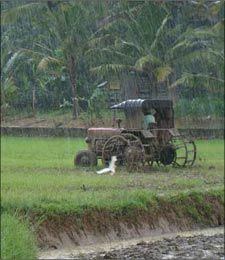 The monsoon is making slow progress across the country, even as millions of farmers eagerly wait for the first showers.
The monsoon is making slow progress across the country, even as millions of farmers eagerly wait for the first showers.
The progress of rains is expected to be slow over the next few days and it is expected to spread over central and eastern India only after Tuesday.
By Saturday, monsoon rain had covered much of Kerala, Tamil Nadu and parts of Karnataka in the south and till Assam in the northeast.
Had the progress been normal, the rain by this time would have reached central India and covered Maharashtra, parts of Gujarat, Madhya Pradesh, eastern Uttar Pradesh, Bihar, Jharkhand and West Bengal.
“The southwest monsoon, as expected, arrived late in the country and thereafter its progress has been rather sluggish.
"With no strong push seen in the next week to 10 days, rain is expected to make a slow march towards the north,” Ajit Tyagi, former director-general of India Meteorological Department told Business Standard.
He said the progress over central and northern India could be delayed due to late onset.
The southwest monsoon was 47 per cent below normal between June 1 and 14, with large parts of central, northern and western India yet to get their first showers.
This year, it arrived in India on June 6, five days behind its usual date of June 1.
In 2009, the previous time when El Niño (a weather phenomenon that causes less rains) had led to a big drop in rain, the southwest monsoon had arrived over Kerala on May 23 -- nearly a week before the normal date.
Thereafter, there was a prolonged hiatus in the advance of the rain in June but it picked up pace in July, covering the entire country by July 3, well before its normal date of July 15.
The rains stayed back for a longer duration and withdrawal had started from September 25 against the normal date of September 1.
The stop-start monsoon had led to the worst drought in almost 30 years, hitting almost 120 districts.
In 2014, the pattern could follow a similar situation, barring the onset date.
The IMD in its second-stage forecast on June 9, a few days after the onset, had estimated the rain at 93 per cent of the 50-year average from 1950 (termed LPA, the long period average), lower than the 95 per cent it had projected in April, both considered sub-normal.
According to IMD, every part of the country, barring the northeast, will receive less than normal rain, with the northwest states likely to be worst-hit.
Paddy, sugarcane, pulses, oilseeds and coarse cereals are grown during the monsoon season, also known as kharif.
The monsoon rain is vital not only for the standing crop but also provides much-needed moisture to the soil for the ensuing rabi season.
“We have to closely watch the progress of rain from June 20, when it makes its march over the crucial western, central and northern parts and only then can we conclude the impact it could have,” said Tyagi.
Mahesh Palawat, chief meteorologist at Skymet Weather Services, said the monsoon’s progress shows remote chance of any strong surge, which will give the rain the necessary impetus.
“By June 17-18, the rain should reach parts of Odisha, West Bengal, Jharkhand and Bihar, a week to 10 days behind schedule,” Palawat added.
Meanwhile, the Union government has drawn a contingency plan for 500-odd districts and listed a host of other measures in the event of a drought or low rain.
“We are ready with our contingency plan and have even firmed up diesel subsidy and loan-restructuring plans, prepared in 2009 after states declared themselves drought-hit,” said a senior official from the department of agriculture, who has been working on drought relief measures.
Experts feel the impact on sowing or agriculture is not much as of now, because the rains have been delayed by only a week to 10 days in most places.
“This is a minor delay and will have little impact on sowing.
"The real crunch will start when paddy sowing begins in full flow by the end of this month as paddy requires a lot of water,” Palawat noted.
According to the agriculture department, rice -- the main kharif crop -- has been sown or transplanted in 0.2 million hectares till Friday; pulses in 0.2 million hectares and oilseeds in 0.08 million hectares, while sugarcane has been planted in 4.4 million hectares and cotton in 1.7 million hectares so far.











